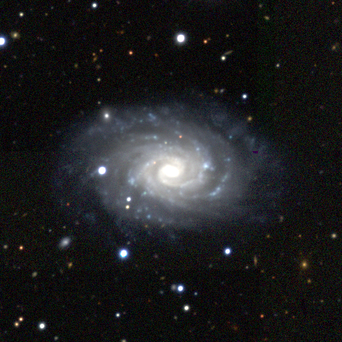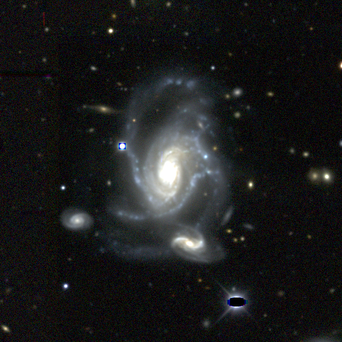About My Research
(Science is cool!)
Current Research

|
|
Testing Environmental Processes Using MUSE Observations of Compact Groups I am the PI of a very cool project to observe compact groups of galaxies with the MUSE IFU. (An "IFU", or integral field unit, is a instrument that measures a spectrum at every pixel in an image.) One of the aims of this project is to test whether or not galaxies in groups significantly grow their core densities as a result of their group environment and interactions. The answer to this question will rule out certain scenarios of "quenching", or how galaxies shut down their star formation (see below). Group environments are the perfect place to catch core growth and quenching in the act because the group environment is where all the action happens (see my paper here). The galaxies pictured above are from a pilot observation of a group that seems to be falling together now, and whose group mass is about the right mass where environmental effects start to be seen. Aside from yielding the most precise stellar population properties to date, MUESLI will also offer an unprecedented view into the outflows and winds that are ignited as a result of group interactions. Our MUSE observations are ongoing, so keep watching this space for cool new plots! |


|
|
The morphology of galaxies, in particular their core density, is strongly correlated with a galaxy's lack of new star formation, or "quiescence". This central density in turn, correlates with the mass of the supermassive black hole that lives in the centres of most galaxies. Thus one popular theory places the blame for quenching squarely on this black hole. A rush of gas towards the centre creates the high central density of stars, a process is called "compaction" because galaxies, in particular their cores, become more compact. The inflowing gas also feeds the black hole, causing it to erupt in a burst of energy that blows remaining gas from its vicinity. The black hole grows by feeding on such inflows until it emits enough energy to remove all gas from the galaxy. Aside from the black hole hypothesis, there are some compelling alternatives. Galaxies are known to grow inside-out. Thus some suggest that perhaps the morphology-quiescence relation isn't a result of morphological transformation at all, but actually a relic of quenching at an earlier time when the universe was dense. I realized that these two scenarios could be distinguished by their stellar age profiles. The compaction scenario predicts that new stars are added to galaxy cores while a passively inside-out growing galaxy will have older centres. So I led an investigation into the stellar age and star-formation rate (SFR) profiles of galaxies in the MaNGA (Mapping Nearby Galaxies at the Apache Point Observatory) survey and found that compact galaxies do indeed seem to have relatively young centres with centrally peaked SFR (see figures above). On the other hand, galaxies with diffuse cores have older centres with low SFR, consistent with an inside-out growing galaxy. Thus it seems that galaxies seem to evolve via both compaction and inside-out growth. For more about this result, especially how this relates to quenching, see my recent paper. |
Past Research
 |
|
The mechanisms that cause the quenching of star formation in galaxies are still unknown. We do know that quiescence is strongly correlated with, among other things, galaxy morphology, which may indicate that morphological transformation is somehow connected to quenching (although there are some compelling alternative views). It is unclear however, how quiescence and morphology are related for satellite galaxies, which may experience a number of different quenching mechanisms than the field. The above plot shows the specific star formation rate (sSFR = SFR/M*) vs. Σ1kpc, a measure of morphology (the stellar mass surface density within 1 kpc). The contours and colour shading represent the number density of galaxies in each pixel. This plot shows that satellites seem to begin quenching (enter the "green valley" or GV) regardless of their Σ1kpc, unlike their field counterparts which all enter the GV at high Σ1kpc. This is evidence that satellites undergo different quenching mechanisms than the field. However satellites that are already quiescent all have Σ1kpc about 0.2-0.3 dex higher than the star-forming or GV satellites. Thus, either 1) Σ1kpc increases after quenching through some satellite processes (eg. tidal or ram pressure compression), or 2) Σ1kpc actually doesn't increase for individual satellites. Rather, some other effect such as tidal stripping reduces their mass so that their Σ1kpc is high for their mass, or their time of quenching was far enough in the past so that their inner density simply reflects the denser universe at the time of quenching. For more about this result, see my paper. |
|
The Dark Energy Survey is a massive photometric survey of ~5000 sq. degrees of sky with deep images of ~300 million galaxies as far as z~2. Due to its sheer size this survey is a gold mine for studying populations of rare objects. I am leading a project to study the structural and photometric properties of a rare population of isolated low-mass quiescent galaxies in order to find clues as to the reason for their quiescence. For this purpose, we have designed and implement a promising new algorithm for identifying isolated galaxies using photometric redshifts. |

 
 |

 |
|
In this paper we demonstrated the role of the halo mass in predicting the quenched fraction of galaxies. In the left panel above, the quenched fraction is plotted in colour scale as a function of the stellar mass M* and the estimated halo mass Mh for central galaxies. At constant M*, the quenched fraction increases strongly with Mh, but not the other way around (ie., the contours are vertical). The right panel shows the quenched fraction of satellite galaxies as a function of group-centric distance D = dproj/Rvir and Mh. Both of these quantities matter for satellites. Far from the group centre, the dependence of the quenched fraction on Mh is weak, but closer in, Mh predicts quiescence quite strongly. Likewise, in low-mass halos, group-centric distance doesn't affect the quenched fraction much, but in massive halos, group-centric distance matters a lot. For more on these results, see this paper |


 |
|
Quiescence doesn't only depend on the halo mass. Morphology also strongly predicts quiescence. The goal of this paper was to compare the roles of the halo and morphology in predicting quiescence. Here, instead of looking at the quenched fraction only, we explored the entire distribution of sSFR. The left panel above shows the sSFR as a function of Σ1kpc (the stellar surface density within 1 kpc - a measure of morphology) and Mh. The sSFR decreases strongly with Σ1kpc at fixed Mh, and only weakly the other way around. The colour scale in this panel is the mean sSFR, but sSFR is a bimodal quantity, so the other two panels explore the whole shape of the sSFR distribution. The middle panel shows the sSFR distribution at fixed Mh. Increasing Σ1kpc brings the star-forming peak down and the quiescent peak up. The right panel on the other hand shows the sSFR at fixed Σ1kpc. Increasing Mh moves the entire distribution downward in sSFR without changing its shape. We suggested the following interpretation of these results: quenching that is associated with Σ1kpc is a more sudden, violent form of quenching, while quenching that is associated with Mh is a slower, more gentle form of quenching. This paper discusses these things in more detail. |
|
I have also worked on semi-analytic modelling, particularly on the GalICS SAM, in order to understand the consequences of certain physical recipes on the observed properties of the galaxy population. Using GalICS, we have studied the role of cold stream accretion and mergers in driving star formation during the most active period of today's massive red and dead galaxies. We have also tested the effect of implementing rapid and slow quenching dependent on bulge or halo properties and found that rapid bulge quenching and slow halo quenching qualitatively reproduces the observed dependence of quiescence on morphology and halo mass. In addition, we showed using GalICS that a simple minimum mass threshhold for star-formation can explain the evolution galaxy "downsizing" (submitted). |
 |


|
|
The dwarf galaxies of the Local Group are a unique laboratory for testing physical mechanisms that may be important for driving galaxy evolution. We found that the scaling relations between their stellar mass, sizes, metallicities and circular velocities form a tight line in phase space that nicely fits the predictions of a picture of supernova feedback that uses simple energy considerations within a ΛCDM framework. |
